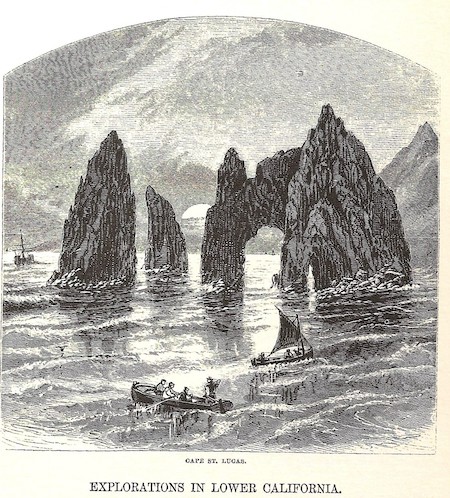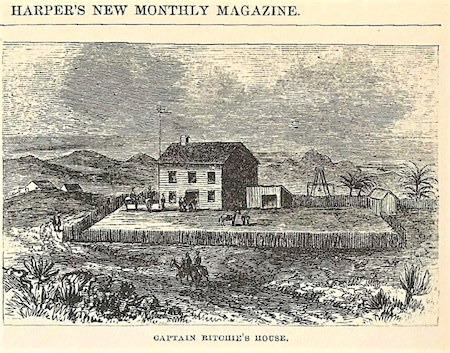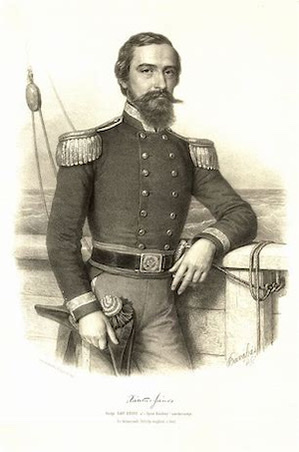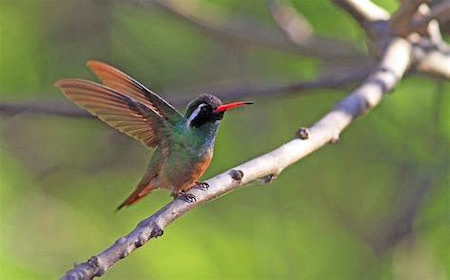 |  |
By Greg Niemann

Captain Ritchie
One of the first Europeans to jump ship in Baja California and live among the Californios was Englishman Captain Thomas Ritchie, the only European settler in the Cape region for much of the 19th century.
In 1828, as a 17-year-old cabin boy on an English whaling ship anchored in San Jose del Cabo, he became enamored with a local señorita and hid out until his ship sailed.
Ritchie remained in the area for over 45 years, where he died in October 1874 at age 64. He eventually had two Mexican spouses (though some say seven) and left a goodly number of offspring.
While his life was fraught with difficulties, his word was considered law. Every visiting sailor had an amiable word for “Old Ritchie” and he was spoken of with great respect.
J. Ross Browne, noted journalist/explorer, arrived on the Peninsula in the mid-1860s and published “Explorations in Lower California,” originally a series of articles in Harper’s New Monthly Magazine (1868). About Captain Ritchie, he wrote:
“Captain Ritchie, an old Englishman, lives here. He is the only European in Cabo, and I mention him since he is one the institutions of the country. His history is one of marked adventure and is full of interest. Ritchie has been the host of all the distinguished navigators who have visited the coast during the past 40 years.
“Smuggling, stock-raising, fishing, farming, and trading have been among his varied occupations. He has made and lost a dozen fortunes, chiefly by selling and drinking whiskey. No man is better known on the Pacific Coast than ‘Old Ritchie.’
“Captain Ritchie’s house at Cape San Lucas is the home of adventurers from all parts of the world. Admirals, commodores, captains, and mates inhabit it; pirates and freebooters take refuge in it; miners, traders and cattle-drovers make it their home. In short, the latchkey is never drawn in. His hospitality is proverbial.
“He has undergone many tribulations at the hands of the Mexicans. They have robbed him, taxed him, imprisoned him, threatened to kill him, but all to no purpose; and they now regard him as an inevitable citizen of their country. Once they confiscated his property and cast him over to prison in Mazatlan; an English man-of-war got him out of there and threatened to bomb the city if he was mistreated or abused anew.
“Because he survived the severe wounds inflicted upon him, which would have killed any other man on Earth, it was said it would be a miracle if he were ever to die.

“Since the opening of the San Antonio and Triunfo mines Captain Ritchie has done a good business in packing freight and passengers to the mines.
Janos Xantus
Besides Captain Ritchie, only a couple of outsiders lived in the Cabo San Lucas area in the mid-1890s. One of these visitors ensured that his name would enter the annals of history by dabbling in ornithology and having several species of birds named after him. He is well known also to students of flora by having plants named after him.
He was Hungarian naturalist Janos Xantus (1825-1894) who lived at Cabo San Lucas for two years (1859-61) where he was employed by the United States Geological Survey for the purpose of measuring tides. He had also agreed to collect specimens of the uncharted flora and fauna of the area for the Smithsonian Institute.
Born in Hungary in 1825, he initially studied law, but joined the Hungarian Army. Xantus was captured in war and imprisoned but managed to escape a year later.
He ventured to the United States in 1851 and began working various jobs before enlisting in the U.S. Army in 1855. During his service time he began collecting natural history specimens. Spencer F. Baird, Assistant Secretary of the Smithsonian Institution, encouraged Xantus to collect extensively for the U.S. National Museum while he was stationed at Fort Tejon, California during the mid-1850s. After his discharge he explored Cape San Lucas, again collecting for Baird.
He eventually returned to Hungary in 1864 and served as the Director of the Zoological Garden of Budapest and as Curator of Ethnography at the Hungarian National Museum. He passed away in Budapest in 1894.
He began his Baja adventure by getting a small boat to take him from La Paz to Cabo San Lucas. Near there he set up his camp some seven miles from his nearest neighbor, the Englishman Captain Ritchie, and 30 miles from the then nearest town, San Jose del Cabo.
Xantus had to haul his drinking water in a goatskin bag those seven miles from a brackish well near Captain Ritchie. Camped on a remote beach where he set up his tide gauge, Xantus was almost completely isolated, receiving irregular news reports from occasional whalers.
Xantus wrote, “The winds blow hard all the time and upset everything in my tent, as there is nothing but quicksand to fasten the pegs in. …. There is a great quantity of birds, and what is most astonishing—an infinite variety of snakes and lizards of enormous size.”
It has been widely acknowledged that, in his considerable spare time, Xantus had observed and collected some 100 new species of animals from the gulf region. Some examples of these firsts include:

--The Xantus Hummingbird (hylocharis xantusii), normally only found in Baja California although in recent years a nest was found in Southern California;
--The Xantus’ Murrelet (synthliboramphus hypoleucus), a small bird with a habitat on rocky ocean islands and the open ocean. It has a highly restricted breeding range.
He is also known to herpetologists from a gecko (phyllodactylus xanti) and the genus Xantusia (night lizards).
Flora to which the name Xantus is affixed includes the plants Xantus’ chaenactis, Xantus’ clarkia and Xantus’ spineflower.
However, for all his legitimate discoveries, Xantus was a controversial naturalist. He has been called a “picturesque liar” and was accused of mislabeling some of his finds. Xantus also appropriated other peoples’ stories of interesting adventures and works previously published in English by others and passed them off as his own. He thus entertained his fellow Hungarians of “his” exciting life and times in Mexico and the western U.S.
One would think that discovering 100 new species to which he is credited would be more than a lifetime of success, but Xantus boasted that he had collected 3,829 new species totaling 92,000 specimens.
He didn’t need to exaggerate or “enhance” his interesting life. Being one of just a handful of foreigners in Baja at the time was more adventure than most people would ever experience.
As if trying to survive on a remote beach wasn’t daunting enough, Xantus also found himself a pawn in a political struggle between the conservatives in San Jose del Cabo and the liberals in La Paz. He was forced to pay a license fee for his tide gates by the conservatives, and the liberals accused him of supporting their enemies’ cause. To punish the foreigner, they confiscated one of his guns, a keg of gunpowder, and killed one of his cows which they consumed for dinner.

Xantus may have had a few run-ins with the political machinery, but apparently, like his neighbor Ritchie, he did not have problems with the Mexican women.
This was documented by John Steinbeck, who arrived in the cape area 80 years later. In his 1941 book Sea of Cortez, Steinbeck gently rebukes the social biases of the time by openly honoring Xantus thusly: “And we do not feel we are injuring his reputation, but rather broadening it, by repeating a story about him.
“Speaking to the manager of the cannery at the Cape, we remarked on what a great man Xanthus (sic) had been. Where another would have kept his tide charts and brooded and wished for the Willard Hotel, Xanthus had collected animals widely and carefully.
“The manager said, ‘Oh, he was even better than that.’ Pointing to three little Indian children he said, ‘Those are Xanthus’s great-grandchildren,’ and he continued, ‘In the town there is a large family of Xanthuses, and a few miles back in the hills you’ll find a whole tribe of them.’ There were giants in the earth in those days.”
Steinbeck concludes, “We wonder what modern biologist, worried about titles and preferment and the gossip of the Faculty Club, would have the warmth and breadth, or even the fecundity for that matter, to leave a ‘whole tribe of Xanthuses.’ We honor this man for all his activities. He at least was one who literally did proliferate in all directions.”
Indeed, both Captain Ritchie and Janos Xantus overcame numerous difficulties, but lived their lives in Baja to the fullest.
About Greg
Greg Niemann, a long-time Baja writer, is the author of Baja Fever, Baja Legends, Palm Springs Legends, Las Vegas Legends, and Big Brown: The Untold Story of UPS. Visit www.gregniemann.com.

Very easy and great price!

Great service, whoever answered my call was very helpful. First time using Baja Bound and I was...